Quantum Computing¶
On this page we are going to present you the quantum computing methods we have developed and made available through our SDK:
-
A mapping and measurement method for electronic structure problem formulations 1
-
A tensor networks based methodology to optimize an Hamiltonian for generating an optimized Hamiltonian to be solved on a classical computer (CPU, GPU) while at the same time generating an improved state with a quantum circuit (Ansatz) to be solved on a QPU. 2
-
Active space selection methods
-
Zero-noise extrapolation
-
Quantum circuit generation methods such as our genetic evolution method in our Xenakis package
-
Our open-source benchmarking framework to test different variational quantum algorithms (VQA) such as VQE, QAOA etc. and other methods (QSE, GQE, CP-SAT).
-
Our research articles and research projects
Mapping and measurement of electronic structure problems via gate-based quantum circuits¶
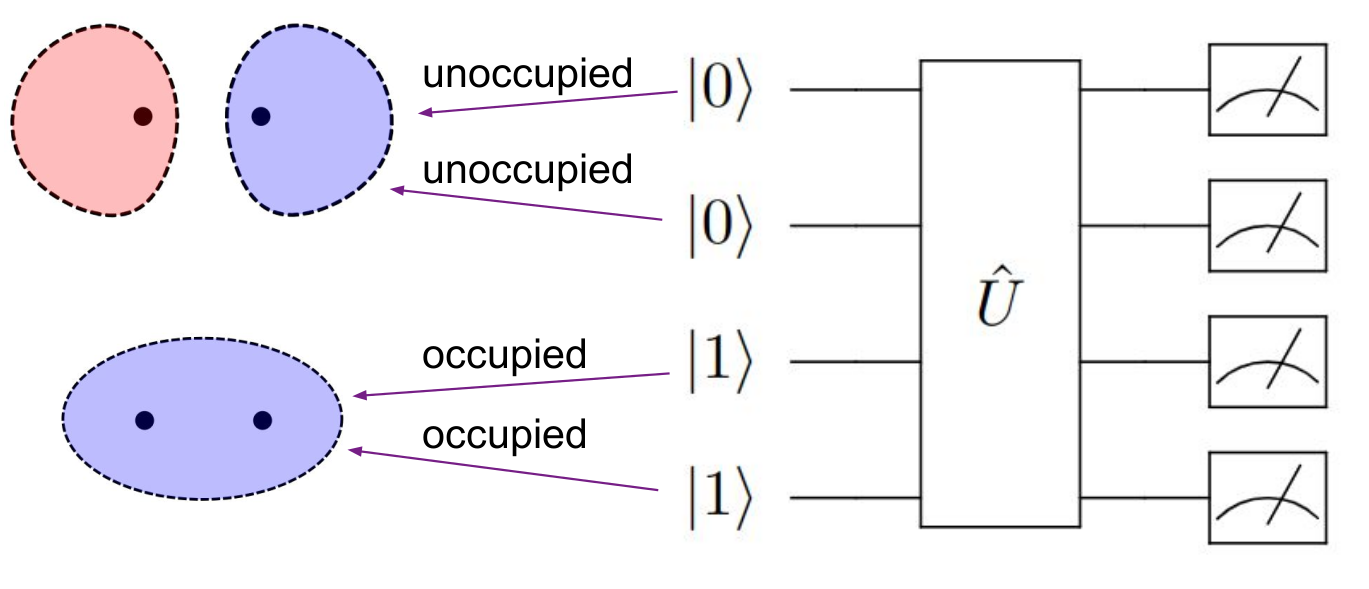
Mapping method¶
Purpose
The mapping method creates a custom encoding of molecular electronic states onto quantum hardware that respects problem constraints (such as fixed electron number and spin multiplicity) while using fewer qubits than standard encodings like Jordan-Wigner.
Key Features
- Reduced Qubit Requirements: Constraint-based mapping significantly decreases the number of qubits needed to represent molecular systems
- Efficient Measurements: Novel measurement scheme reduces circuit complexity for Hamiltonian expectation value estimation
- No Approximations: Methods preserve the full physics of the quantum chemistry problem
- Classical Preprocessing: Resource-intensive calculations performed classically, executed only once per problem
Benefits
- Automatic Constraint Enforcement: VQE optimization is confined to physically valid states
- Faster Convergence: Smaller search space leads to more efficient optimization
- Hardware Efficiency: Fewer qubits required, especially beneficial for larger basis sets
- Exact Results: No approximations to the underlying physics
How It Works
-
Define Constraints: Specify physical constraints for your molecular system:
-
Number of electrons (typically matching nuclear charge for neutral molecules)
- Spin multiplicity (singlet, doublet, triplet, etc.)
-
Spatial symmetries (optional)
-
Identify Valid States: The method identifies the subspace of Fock space states that satisfy all constraints. For N spin orbitals and M valid states satisfying constraints, only \(log_2(M)\) qubits are needed instead of N qubits.
- Generate Custom Mapping: A bijective mapping operator D is constructed that maps the valid subspace to computational basis states on the quantum computer.
- Transform Hamiltonian: The molecular Hamiltonian is transformed to operate in the reduced Hilbert space: \(H_H= D H D^{\dagger}\)
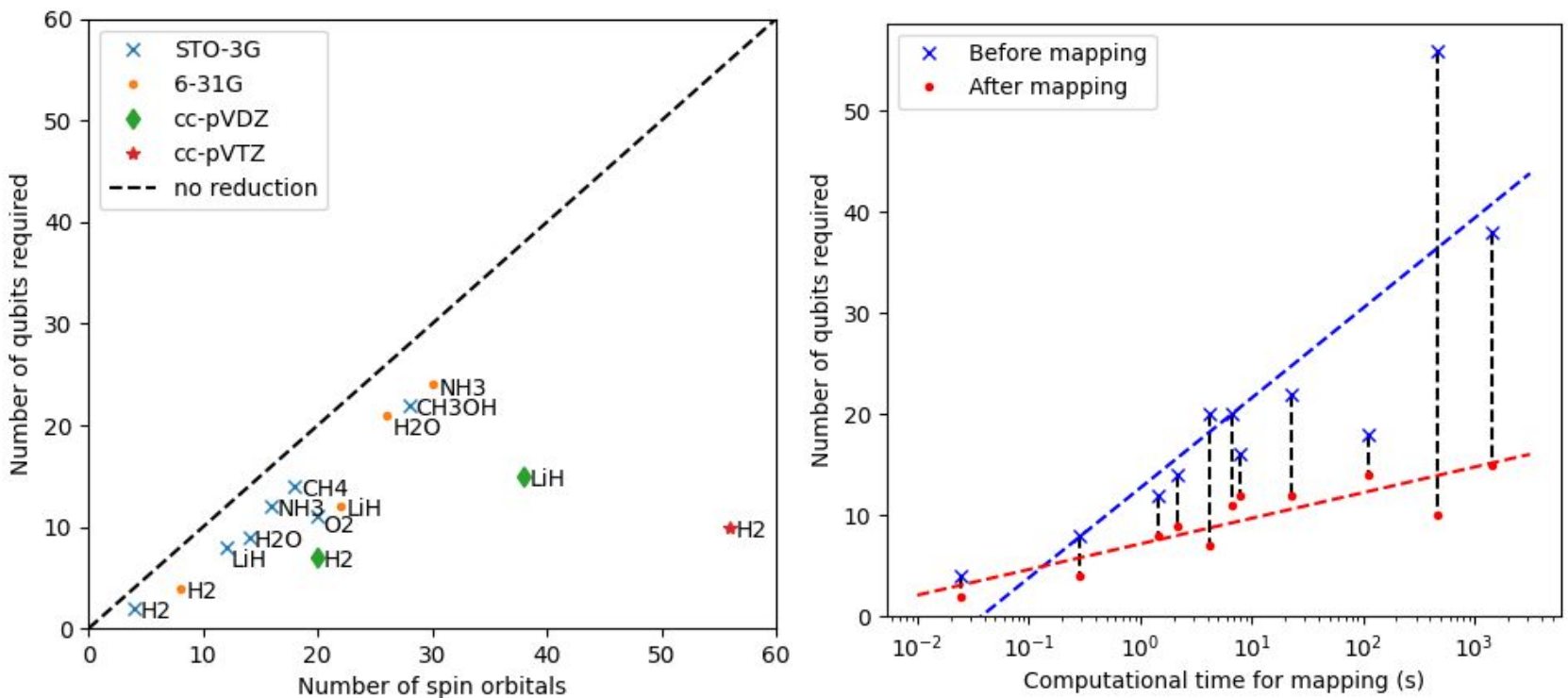
The MQS mapping task can be run via the Cebule SDK in the following way:
TaskType: Mapping
- Inputs
H_coeff_values: array 1-d, list The coefficients of the Hamiltonian to map. (Default: None)
second_quantized_operators: tuples Each tuple is a single operator and multiple tuples in a tuple indicate multi-operators. The first element of a single tuple is the index of the operator and the second element of the tuple denotes via True or False if the operator is a creation operator (True; 1) or a annihilation operator (False; 0). See also OpenFermion FermionOperator
-
Optional Inputs
-
Output
H_new: array 1-d, list Generated Hamiltonian with the mapping method.
Measurement method¶
Purpose
The measurement method efficiently evaluates the expectation value of the mapped Hamiltonian using a novel circuit generation scheme that groups terms by computational basis state pairs rather than Pauli string decomposition.
How it works
Express Hamiltonian in Basis States: The Hamiltonian is written as:
where \(\ket{m}\) and \(\ket{m'}\) are computational basis states.
Partition Terms: Terms are divided into two groups:
Diagonal terms (\(m = m'\)): Measured directly in computational basis Off-diagonal terms (\(m \neq m'\)): Require basis rotation circuits
Generate Measurement Circuits: For off-diagonal terms, circuits are grouped by which qubits differ between \(\ket{m}\) and \(\ket{m'}\):
Terms with the same "active qubits" are measured simultaneously Each group requires one Hadamard gate and CNOT gates Maximum of \(2M\) circuits needed (where \(M\) is dimension of mapped space)
Extract Expectation Values: Measurement probabilities combined with Hamiltonian coefficients yield \(\braket{H}\)
Benefits
- Fewer Unique Circuits: Typically requires fewer measurement circuits than Pauli string grouping methods
- Simultaneous Measurements: Multiple Hamiltonian terms measured per circuit
- Hardware Flexibility: Circuit topology can be adapted to quantum device connectivity
- Shallow Circuits: Measurement circuits have low depth, reducing decoherence effects
TaskType: Measurement
-
Inputs
-
Optional Inputs
-
Output
Combining the mapping and measurement methods¶
Combined Performance
When used together, the mapping and measurement methods provide synergistic benefits:
| Molecule | Basis | Qubits (JW) | Qubits (Mapped) | Pauli Terms | Measurement Circuits |
|---|---|---|---|---|---|
| H2 | STO-3G | 4 | 2 | 14 | 2 |
| LiH | STO-3G | 12 | 8 | 630 | 255 |
| H2O | STO-3G | 14 | 9 | 1085 | 512 |
| BeH2 | STO-3G | 14 | 11 | 665 | 1943 |
| CH4 | STO-3G | 18 | 14 | 9260 | 16384 |
The number of measurement circuits after mapping approaches the theoretical maximum of \(2^Q\) where \(Q\) is the number of qubits after mapping, indicating the mapped Hamiltonians encode information efficiently.
The following table shows the qubit requirements for water with respect to different basis sets and frozen orbitals:
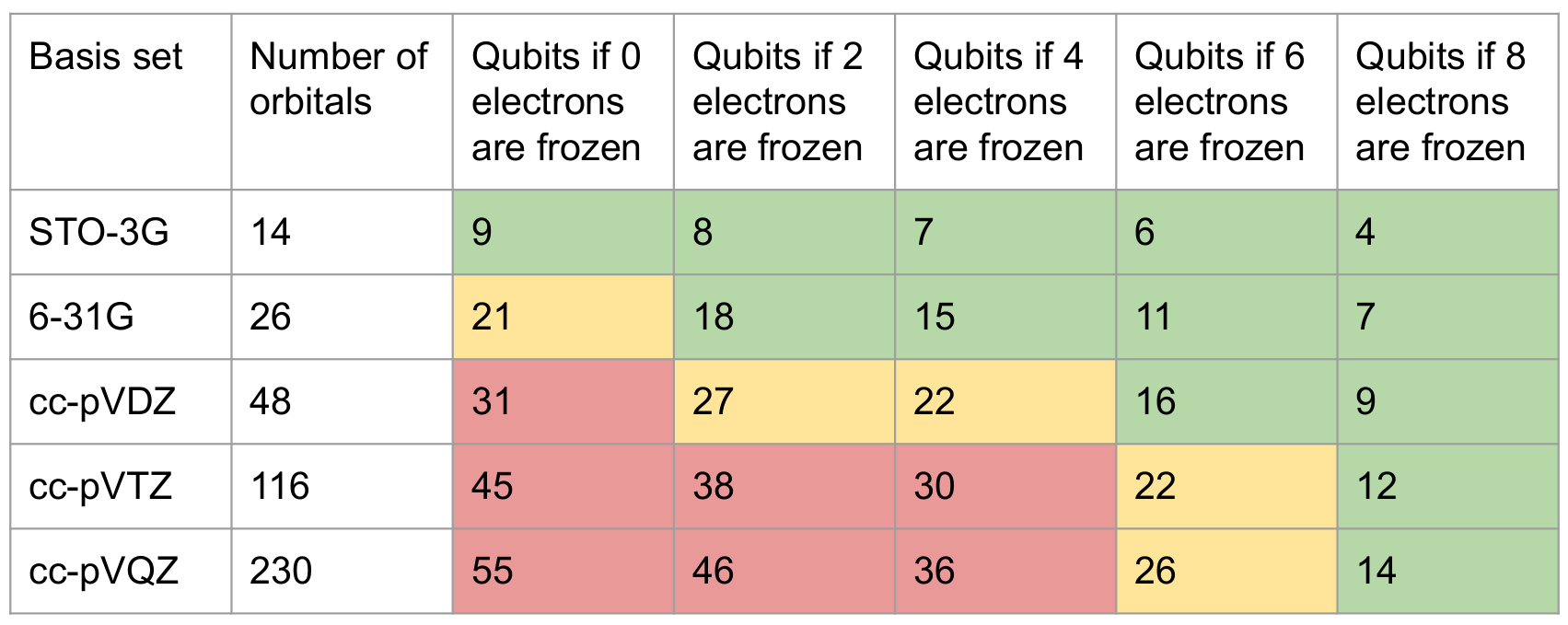
Efficient quantum computing with parameterized tensor networks as matrix product states (MPS) and operators (MPO)¶
Tensor networks have shown that they can be applied to encode quantum chemistry problems in a highly efficient way to apply calculation routines for various molecular properties.
The TN-VQE method depicted in our paper 2 was the starting point for us to develop a tensor network based approach to leverage classical computing to perform as much computational effort for a quantum chemistry calculation as possible to only make the most crucial calculation run on a QPU.
The Tensor Network-Assisted Variational Quantum Eigensolver (TN-VQE) is a hybrid quantum-classical algorithm that combines the strengths of tensor network methods with the Variational Quantum Eigensolver (VQE) to improve convergence and accuracy when finding ground state energies of quantum systems. The tensor network construction can be separated from the specific quantum algorithm (VQE) and one can combine the generated Hamiltonian in different ways with other algorithms.
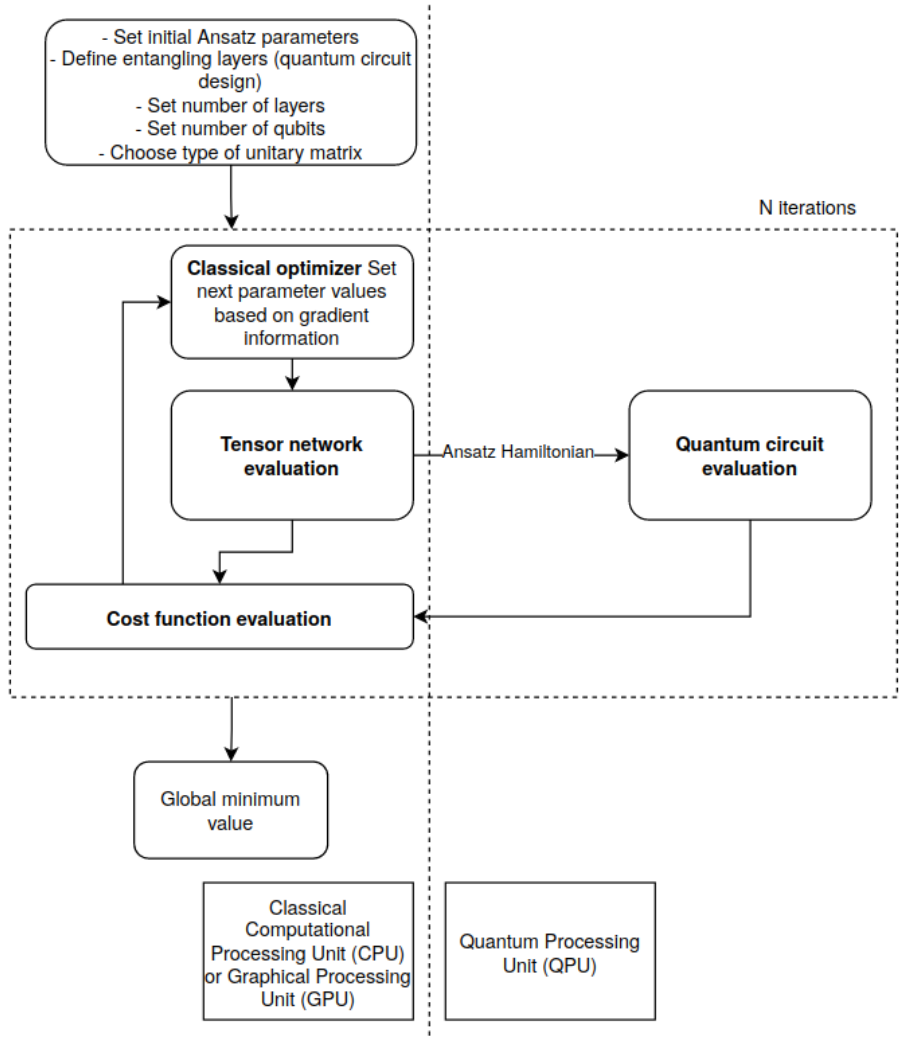
Purpose
Traditional VQE algorithms face several challenges on current NISQ (Noisy Intermediate-Scale Quantum) devices:
- Barren plateaus: Optimization landscapes where gradients vanish, causing the algorithm to stall
- Initialization sensitivity: Poor choice of initial parameters can prevent convergence
- Shallow circuit limitations: NISQ devices require shallow circuits, limiting expressiveness
TN-VQE addresses these challenges by incorporating parameterized tensor networks to better represent the quantum many-body system before the quantum circuit optimization.
Benefits
- Improved convergence: TN-VQE demonstrates better convergence compared to randomly-initialized quantum circuits, particularly for circuits with fewer layers where standard VQE often fails to converge.
- Reduced circuit depth: The tensor network assists the quantum circuit by better encapsulating the complexity of quantum many-body systems, allowing accurate results with shallower circuit depths suitable for NISQ devices.
- Better gradient properties: The TN-VQE approach exhibits smaller gradient magnitudes during optimization, suggesting: More efficient parameter updates, a smoother optimization landscape and reduced sensitivity to noise in quantum simulations.
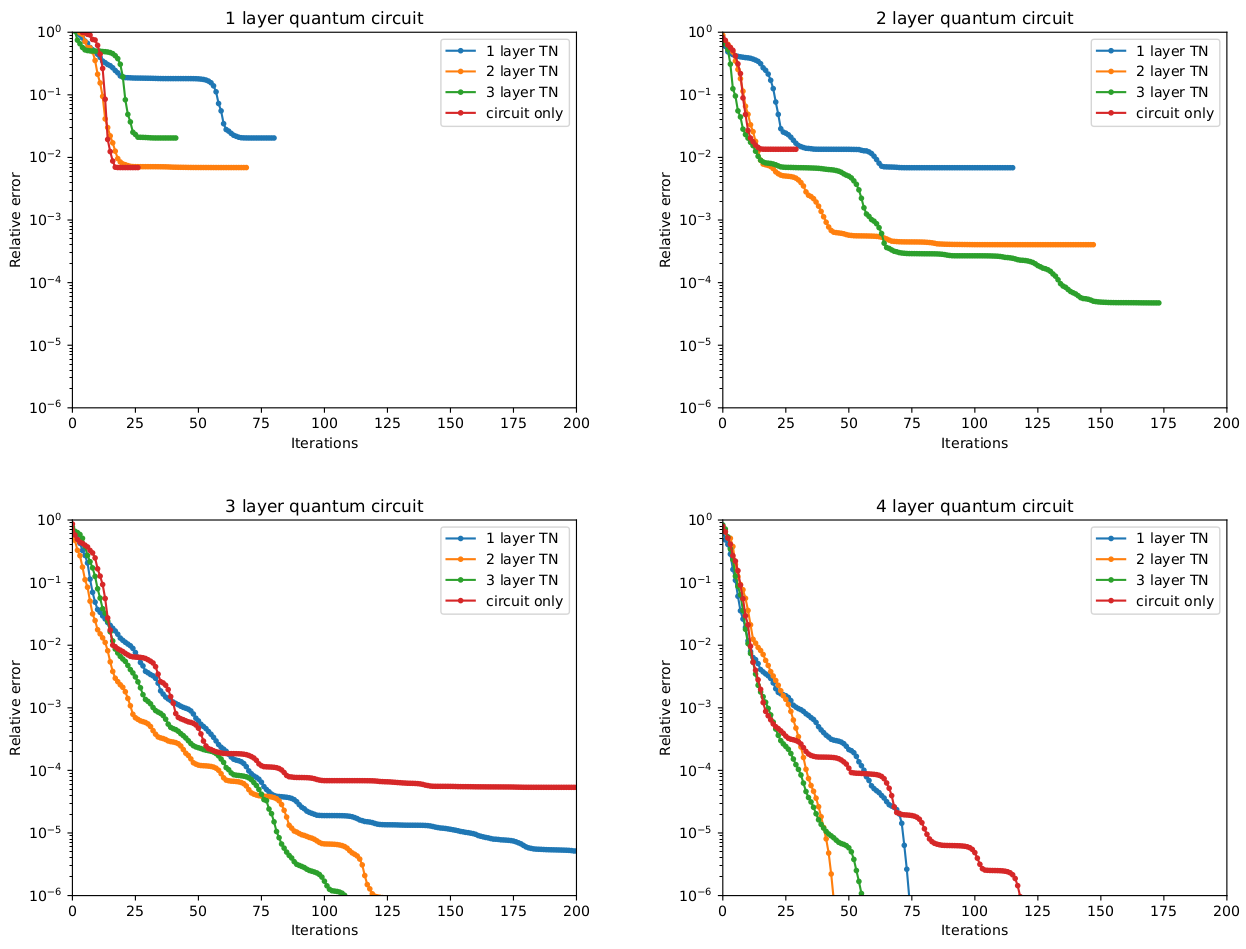
How It Works
The TN-VQE splits the optimization task between a classical tensor network and a quantum circuit. The minimization problem becomes:
where:
- \(U(\theta)\): Parameterized unitary tensor network (classical)
- \(U(\phi)\): Parameterized quantum circuit (quantum)
- \(H\): Problem Hamiltonian
-
\(\theta, \phi\): Parameters optimized simultaneously
-
Hamiltonian representation: The system Hamiltonian is encoded as a Matrix Product Operator (MPO).
- Unitary tensor network: A parameterized classical tensor network \(U(\theta)\) wraps around the Hamiltonian, improving its representation. Quantum circuit: A standard parameterized quantum circuit \(U(\phi)\) prepares quantum states.
- Joint optimization: Both \(\theta\) and \(\phi\) are optimized simultaneously using gradient descent.
TaskType: TNQCOpt
- Inputs:
H_coeff_values: array 1-d, list The coefficients of the Hamiltonian to map. (Default: None)
second_quantized_operators: tuples Each tuple is a single operator and multiple tuples in a tuple indicate multi-operators. The first element of a single tuple is the index of the operator and the second element of the tuple denotes via True or False if the operator is a creation operator (True; 1) or a annihilation operator (False; 0). See also OpenFermion FermionOperator
n_iterations: int Number of maximum iterations for optimization
n_layers_network: int Number of layers for the classical tensor network, parametarized by theta
n_layers_circuit: int Number of layers for quantum circuit, parametarized by phi
- Optional Inputs:
three_para_tn: bool Logical arguments on wheter the rotation gates that make up the tensor network layers are parametarized by 3 parameters (arbitrary rotation) or 1 parameter (only phase rotation) (Default: True)
qasm_ansatz: string QASM circuit ansatz as parameterized quantum circuit via directives with input arrays (Default: strongly entangled layers circuit)
theta_init: array Initial guess for theta parameters (defining the tensor network \(U(\theta)\)). (Default: zeros)
phi_init: array Initial guess for phi parameters (defining the quantum circuit \(U(\phi)\)). (Default: random)
conv_tol: float Convergence tolerance
opt_method: string Currently the default is 'BFGS'. In the future other methods will be available.
- Outputs:
VQE_energy: float The ground state energy of the input Hamiltonian.
H_TN_opt_second_quantized: array 1-d, list The coefficients of the optimized tensor network Hamiltonian.
second_quantized_operators: tuples Each tuple is a single operator and multiple tuples in a tuple indicate multi-operators. The first element of a single tuple is the index of the operator and the second element of the tuple denotes via True or False if the operator is a creation operator (True; 1) or a annihilation operator (False; 0). See also OpenFermion FermionOperator
H_TN_opt_qubit: array 1-d, list
qubit_operators: list of strings
theta: array (floats) The values of theta reached during the optimization.
phi: array (floats) The values of phu reached during the optimization.
You can apply the matrix product state encoding based optimization method via tensor networks of a molecule in the following way with the Cebule SDK:
When the MPS encoding has completed you can again, as shown with the mapping and measurement methods above, run a VQE routine:
This also allows to combine the mapping, measurement and MPS encoding for the VQE routine with the following SDK task:
Correlation optimized virtual orbitals (COVO)¶
The COVO method addresses a fundamental challenge in quantum computing simulations of molecular systems: reducing the dimensionality of the problem while capturing significant electron correlation. Traditional approaches using Hartree-Fock virtual orbitals often fail to capture meaningful correlation energy, particularly when using plane-wave basis sets where virtual orbitals tend to be scattering states with weak interactions.
COVO generates optimized virtual orbital spaces specifically designed to capture electron-electron correlation efficiently, enabling accurate quantum chemistry calculations with far fewer orbitals than conventional methods.
Key Features¶
- Efficient Correlation Capture: Captures significant correlation energy with a minimal number of virtual orbitals (typically 4-18 orbitals)
- Plane-Wave Compatibility: Specifically designed to work with pseudopotential plane-wave Hamiltonians, extending quantum chemistry methods beyond traditional atomic basis sets
- Systematic Convergence: Demonstrates steady convergence toward benchmark results as more virtual orbitals are added
- Quantum Computing Ready: Dramatically reduces qubit requirements for near-term quantum devices while maintaining accuracy
- Pairwise Optimization: Generates virtual orbitals by optimizing small configuration interaction (CI) Hamiltonians containing pairwise electron correlations
- Periodic System Extension: Can be extended to periodic systems using Filon integration strategies for exact exchange and Brillouin zone integration
Benefits¶
Reduced Computational Cost: With just 4 COVOs, the method can recover a significant portion of correlation energy comparable to much larger basis set calculations (e.g., matching cc-pVTZ results with only 4 virtual orbitals for H2).
Near-Term Quantum Device Compatibility: By reducing the number of required qubits while maintaining accuracy, COVO makes quantum simulations feasible on current noisy intermediate-scale quantum (NISQ) devices.
Versatile Applications: The optimized orbital spaces can be used with various many-body methods including: - Full Configuration Interaction (FCI) - Coupled Cluster (CC) theory - Møller-Plesset perturbation theory - Variational Quantum Eigensolver (VQE) - ADAPT-VQE
Extensivity: Maintains proper size-extensivity for dissociated systems, with errors decreasing systematically as more COVOs are included.
How It Works¶
The COVO algorithm generates virtual orbitals sequentially by optimizing small select CI Hamiltonians:
-
Initialization: Start with filled Hartree-Fock orbitals from a reference calculation
-
Pairwise CI Construction: For each virtual orbital to be optimized (φᵥ), construct a small CI Hamiltonian containing:
- The ground state filled orbitals
- The current virtual orbital being optimized
-
Configuration state functions representing electron pairs
-
CI Diagonalization: Diagonalize the CI matrix to obtain expansion coefficients and the lowest eigenvalue
-
Gradient Optimization: Calculate the gradient of the energy with respect to the virtual orbital and update using conjugate-gradient or similar optimization methods
-
Orthogonality Constraint: Ensure the new virtual orbital remains normalized and orthogonal to all previously computed filled and virtual orbitals
-
Iteration: Repeat for the next virtual orbital until the desired number of COVOs is generated
Zero-noise Extrapolation for Variational Quantum Algorithms¶
Variational Quantum Algorithms (VQAs) like the Variational Quantum Eigensolver (VQE) are specifically designed to run effectively on near-term quantum computers, which lack quantum error correction. Consequently, there’s substantial interest in determining whether these algorithms can provide practical computational advantages. In chemistry, accurately predicting molecular energies with classical methods (such as Density Functional Theory, Coupled Cluster, and Full Configuration Interaction) can be extremely computationally expensive. Quantum computing, with its natural ability to represent quantum entanglement and correlations between particles, has the potential to significantly accelerate these calculations. Thus, enhancing VQAs through error mitigation methods such as Zero-noise Extrapolation (ZNE) is relevant to areas such as pharmaceuticals, energy, and catalysis – which together have a global market size of trillions of dollars – for molecular and material design both in industry and academic research.
ZNE works by intentionally increasing noise in quantum circuits via redundant gates, measuring the expectation value of a circuit with respect to some operator at different noise levels, and then extrapolating with a curve fit to estimate the zero-noise result.
MQS has systematically benchmarked different ZNE configurations – combinations of noise factors, noise amplification methods, and extrapolation techniques – to identify which configurations yield the most accurate and reliable improvements to VQE, as well as which configurations lead to unrealistic energy estimates.
We ran a series of experiments to benchmark various ZNE configurations for VQE using Qiskit and classical simulation with the IBM Brisbane noise model. From the experiments run, the best-performing ZNE configurations for the analyzed VQE cases in terms of stability and accuracy involve a large number of noise scalars (such as 12 factors between 1 and 6.5), two-qubit gate folding, and quadratic extrapolation. The cubic and exponential extrapolation methods can be prone to producing unphysical energies. By mapping which options consistently converge toward the noiseless energy and which diverge, a recipe for reliable error mitigation in VQE is provided.

ZNE can help one progress towards chemical accuracy with VQAs as shown in our results from the best-performing configuration. Note that this experiment was not tuned for chemical accuracy, it simply demonstrates how ZNE can take one closer to that target.

Genetic gate-based quantum circuit generation¶
See Xenakis repository: Link
Benchmarking framework¶

Quantum computing research articles¶
- Resource efficient method for representation and measurement of constrained electronic structure states with a quantum computer
- A joint optimization approach of parameterized quantum circuits with a tensor network
- Comparative Studies of Quantum Annealing, Digital Annealing, and Classical Solvers for Reaction Network Pathway Analysis and mRNA Codon Selection
Current projects MQS is taking part in or has completed:¶
PhotoQ: Photonic quantum computing project involving measurement-based quantum computing and Gaussian boson sampling (GBS).
DLR Quantum Computing Initiative - QuantiCoM Project: Advanced water simulations with classical and quantum computing.
Q-Chemion: end to end quantum computing calculation pipeline with QEDMA, Oxford Ionics, Copenhagen University and the Technical University of Denmark (DTU).
MQS x Fraunhofer SCAI Benchmarking Framework: In collaboration with Fraunhofer MQS has developed a quantum computing algorithms benchmarking framework to assess methods related to quantum computing enhanced quantum chemistry calculations.
Quantum Innovation Challenge: Quantum Innovation Challenge in collaboration with Novo Foundation, BioInnovation Institute (BII), DCAI, QAI Ventures and many more. The annual challenge focuses on applications of quantum computing within the life sciences.
-
Kaur Kristjuhan and Mark Nicholas Jones. Resource efficient method for representation and measurement of constrained electronic structure states with a quantum computer. 2023. URL: https://arxiv.org/abs/2303.01122, arXiv:2303.01122. ↩
-
Clara Ferreira Cores, Kaur Kristjuhan, and Mark Nicholas Jones. A joint optimization approach of parameterized quantum circuits with a tensor network. 2024. URL: https://arxiv.org/abs/2402.12105, arXiv:2402.12105. ↩↩